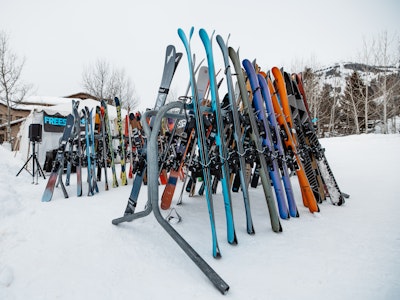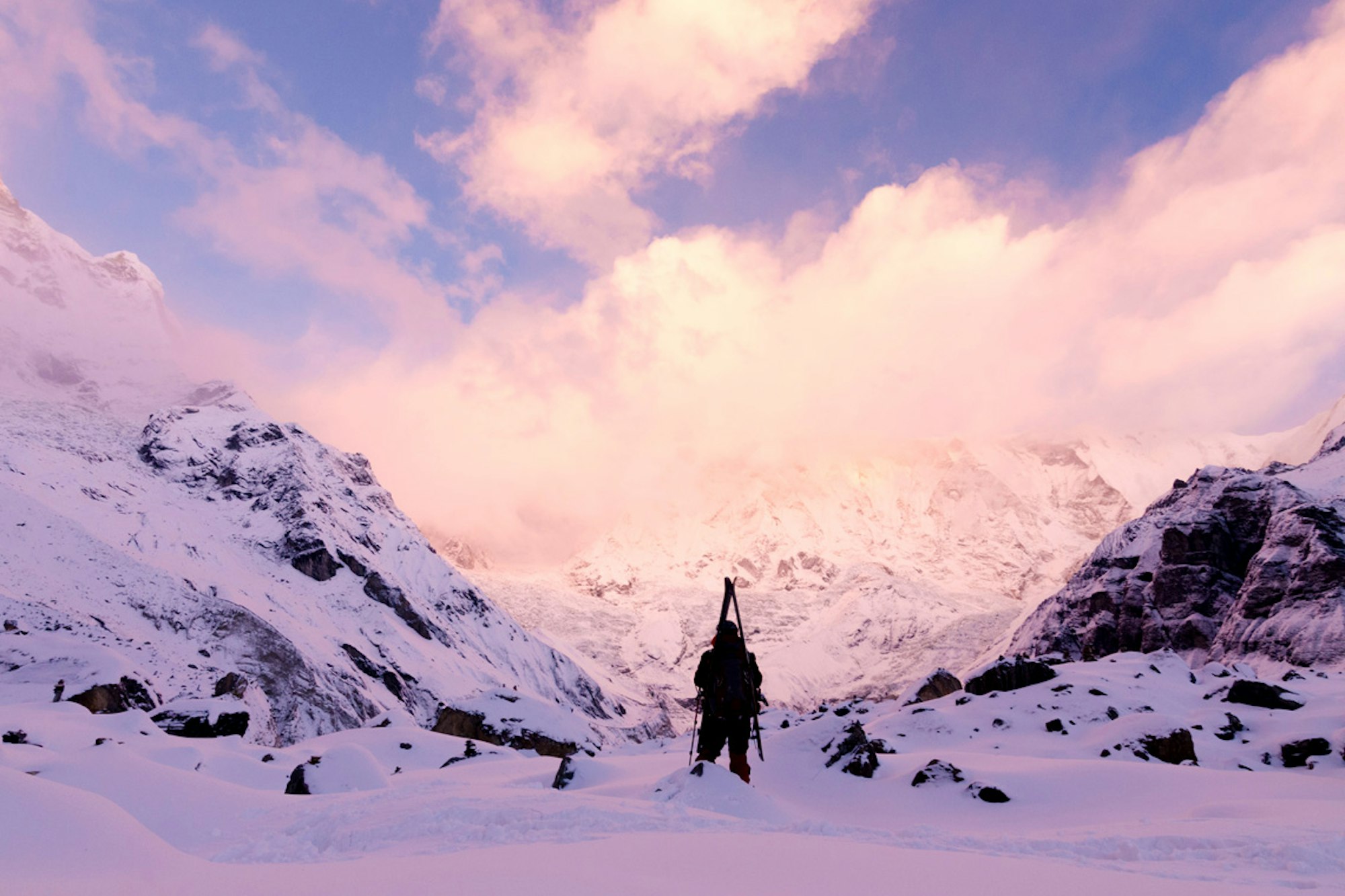Often referred to as the “Roof of the World,” the Himalayas are home to eight of the tallest mountains on the planet and over one hundred peaks exceeding 23,600 feet above sea level, including the goliath Mount Everest which tops out at 29,029 feet. The iconic range extends through China, Bhutan, Pakistan, India and Nepal and has attracted international mountaineers and climbers for decades; it’s a mystical, rugged mountain range that offers endless adventure. Skiers have not widely regarded the Himalayas as a popular destination, but local interest in the sport is steadily increasing.
Looking back at the year 1953 provides an insightful chronological comparison of the mountaineering development between the Himalayas and the Alps. At that time, the world saw the first summit of Everest, which was achieved by Tenzing Norgay and Sir Edmund Hillary. Halfway across the world, the same year saw a catalyst in the history of ski mountaineering with the first modern-style, steep-skiing descent of Mont Blanc by Bil Dunaway and Lionell Terray. While climbers in the Himalayas were celebrating ascents, mountaineers in the Alps were already mastering efficient descents. It wasn’t until 1970, nearly 17 years after its summit had been conquered, that a Japanese alpinist by the name of Yuichiro Miura became the first person to ski Everest.
For a country whose foundation of tourism thrives on local mountaineering guides, the ideal companion sport of skiing has yet to be integrated fully into the Nepali culture. Although foreigners have come to the Himalayas over the years in search of steep lines, locals are for the most part uneducated and unfamiliar with how to approach the mountains with skis on their feet. In an attempt to modernize the Nepali Himalayas in the outdoor adventure sports world, a new non-profit foundation is introducing the sport of backcountry skiing to the indigenous people of the area.
Dubbed The Ski and Snowboard Nepal Foundation (NFSS), the organization recognizes the country’s recreation potential and feels the Nepali Himalayas are now ready to be ascended and descended by more than just climbers.
The NFSS formed in 2016 and aims to help only in the purest, most sustainable ways possible. Barely a year old, the foundation was created by Julius Seidenader and Utsav Pathak with the vision to build a ski and snowboard school within the Nepali Himalayas where guides and locals can learn the sport in a safe and ethical practice. Seidenader received his ski and snowboard instructor license while studying in Whistler, British Columbia and avalanche safety courses throughout Germany, Austria and Switzerland. His current goal for the foundation is to train interested Nepali guides over the next year and eventually select qualified candidates for a 14-day training camp in Austria and Germany, where they will receive international instructor certifications. Seidenader defines the objective of the NFSS as such:
“We don’t want ski infrastructure like in the Alps. Ski mountaineering is the best way of making skiing affordable for everyone and the use of existing infrastructure as much as possible to keep the mountains clean.”
Pathak agrees, noting that an important guideline of the foundation and its members is to preserve the mountains by keeping the environment unobstructed.
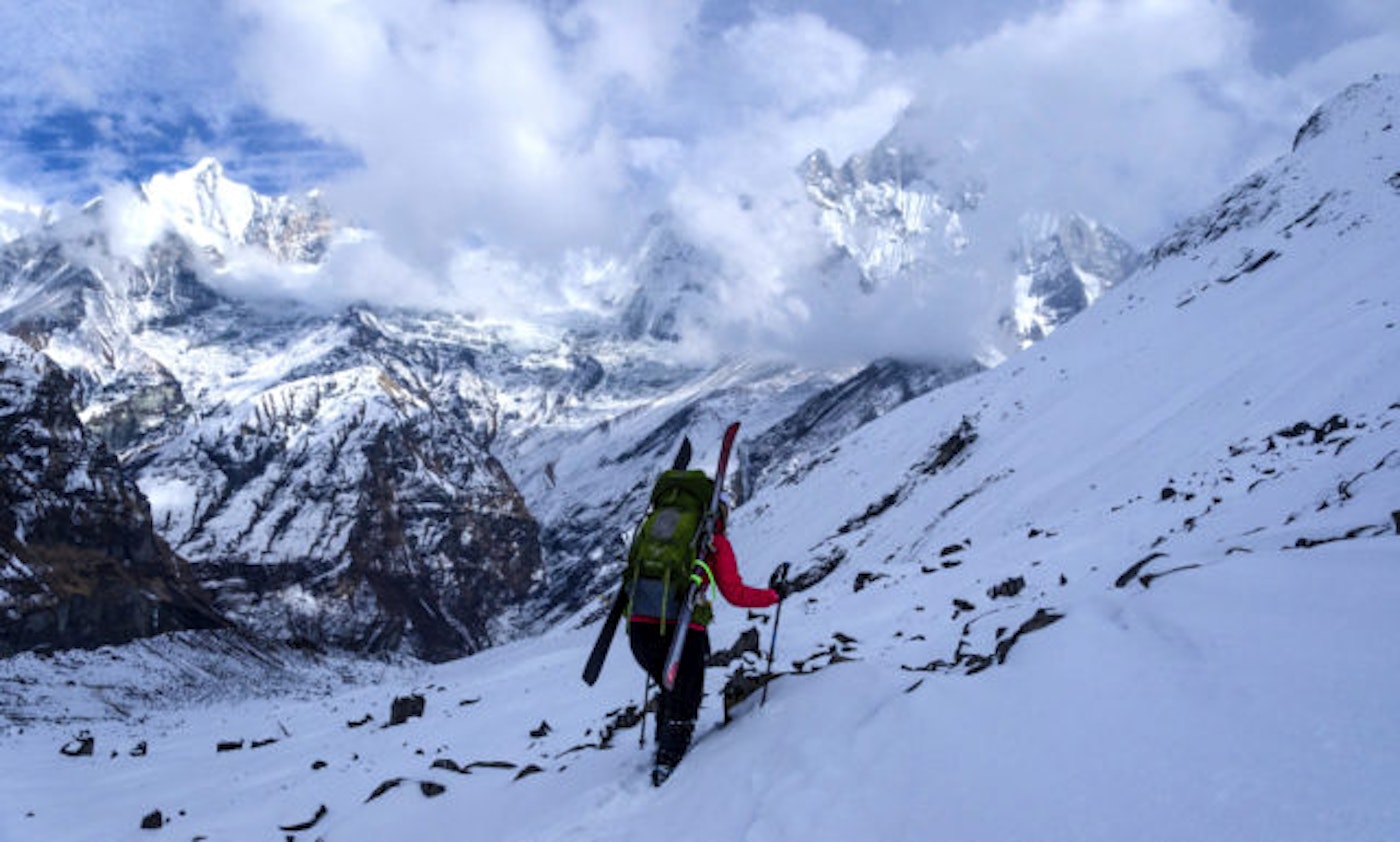
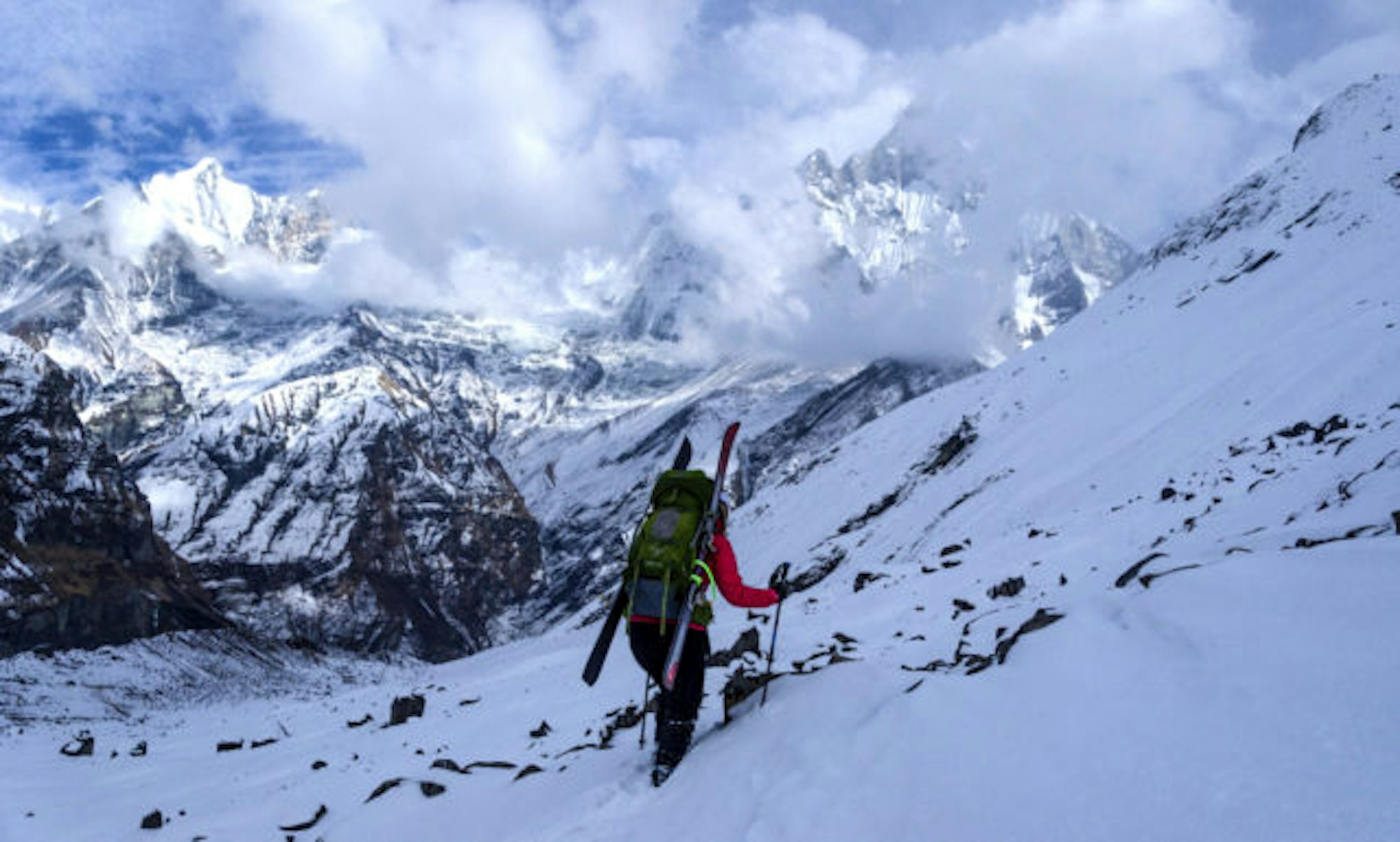
Already a member of the World Snowboard Federation and waiting for approval to join the International Ski Mountaineering Federation, the NFSS is gathering momentum and seeing early success. Currently the foundation has led several descents of popular trekking mountains including the first Nepali team to ski Mera Peak (21,090 feet) and the first ski descent of Ramdung Go (19,520 feet). In addition to accomplishing first descents, twice a year the NFSS hosts a training series for locals where international guides from countries such as Germany and Austria fly to Nepal to instruct avalanche safety, basic ski skills and more.
Intrigued by the authenticity of the backcountry experience promised in Nepal, my partner Jason Juhala and I decided to test the Himalayan snow ourselves. Partnered with the NFSS to help develop area knowledge and route-planning in the Annapurna Range, we traveled the popular trekking route to Annapurna Base Camp (ABC). The expedition totaled 14 days and traveled from 5,900 feet to 13,500 feet. With mountaineering and skiing gear, medical supplies and more, our packs each weighed roughly 60 pounds, and carrying a burdensome load without assistance resulted in our approach to ABC lasting six days.
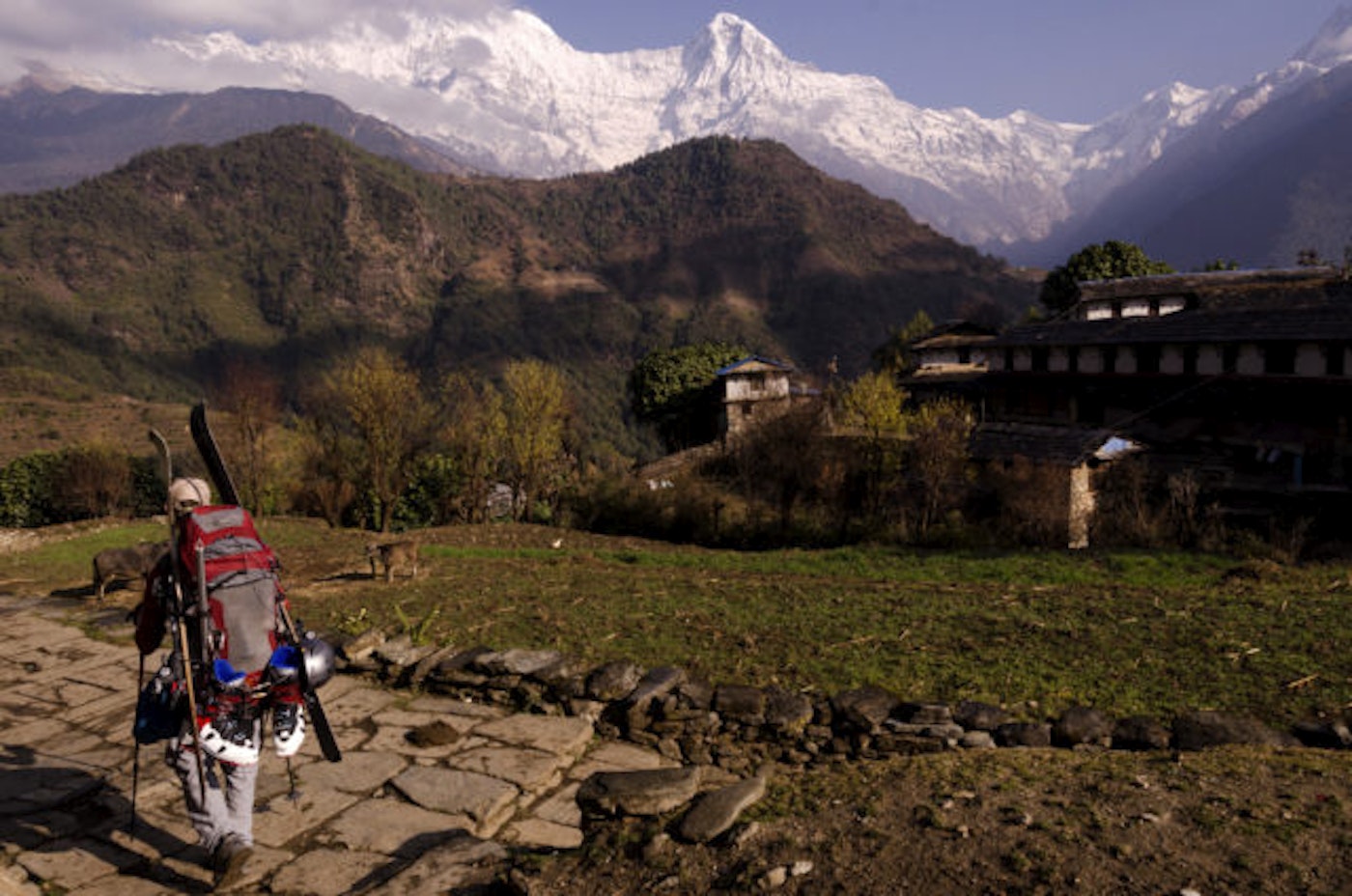
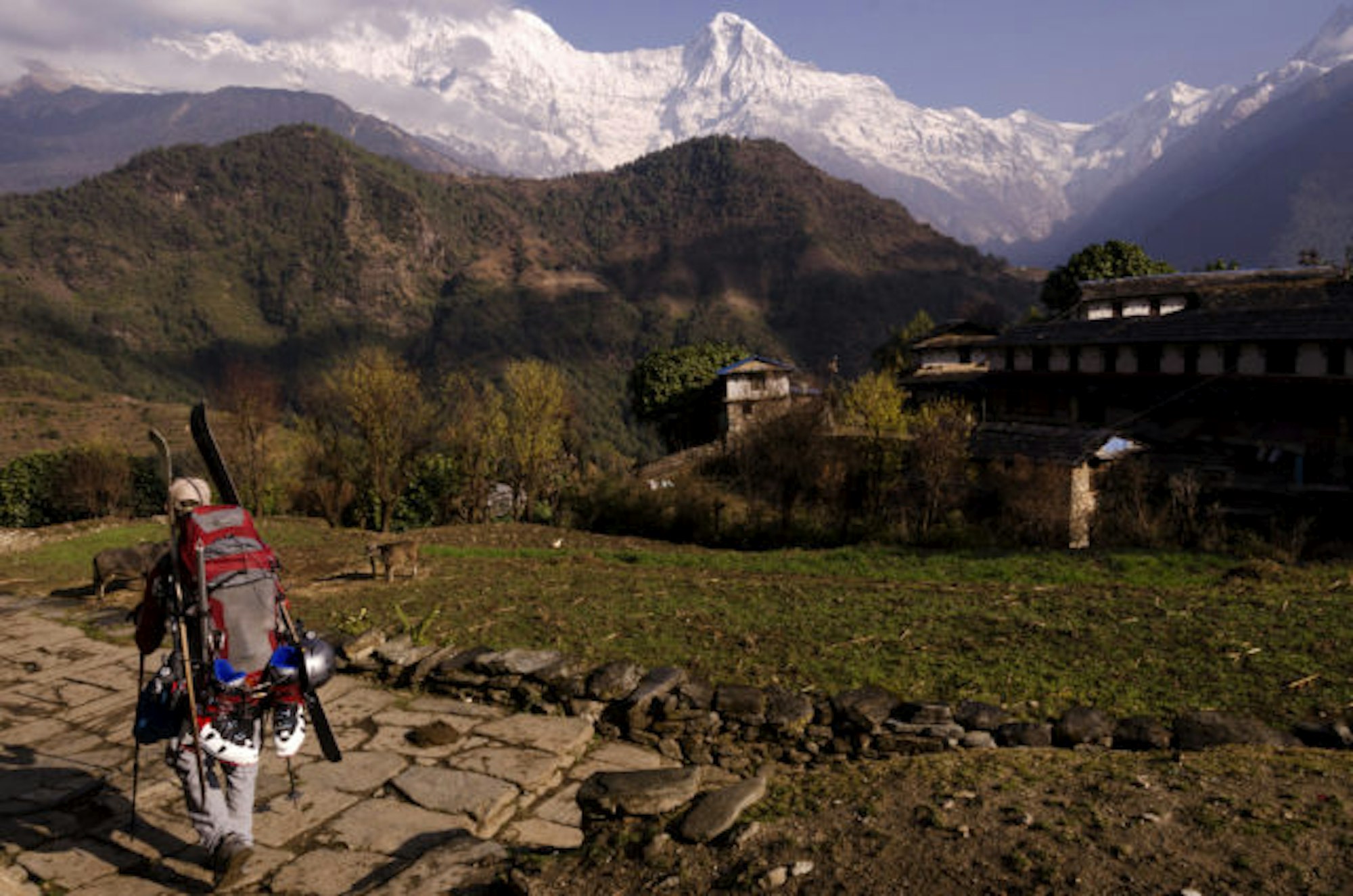
The small subtropical foothills of Naya Pul, which hosts many sunny days and temperatures near 60-degrees Fahrenheit, acts as the the trailhead to base camp. Slowly, the journey travels along to glacial river valleys hosting boulder fields that then climb to the cold alpine climate where temperatures drop to around five degrees at night. While en route, we felt on the forefront of the sport as in the days of explorers and pioneers. Locals and trekkers alike became inquisitive as to the bizarre “sticks” protruding from our packs. Most individuals from eastern countries such as Nepal, India and Korea were astonished at the goal of skiing at ABC. Many stopped to ask us if skiing at base camp is even possible—almost always followed by their personal opinion that it wasn’t. Travelers from western countries were equally curious, yet in a less disbelieving sense. Instead, westerners questioned us about how we were going to manage skiing, where we obtained gear, what lines we planned to ski or how we researched the area.
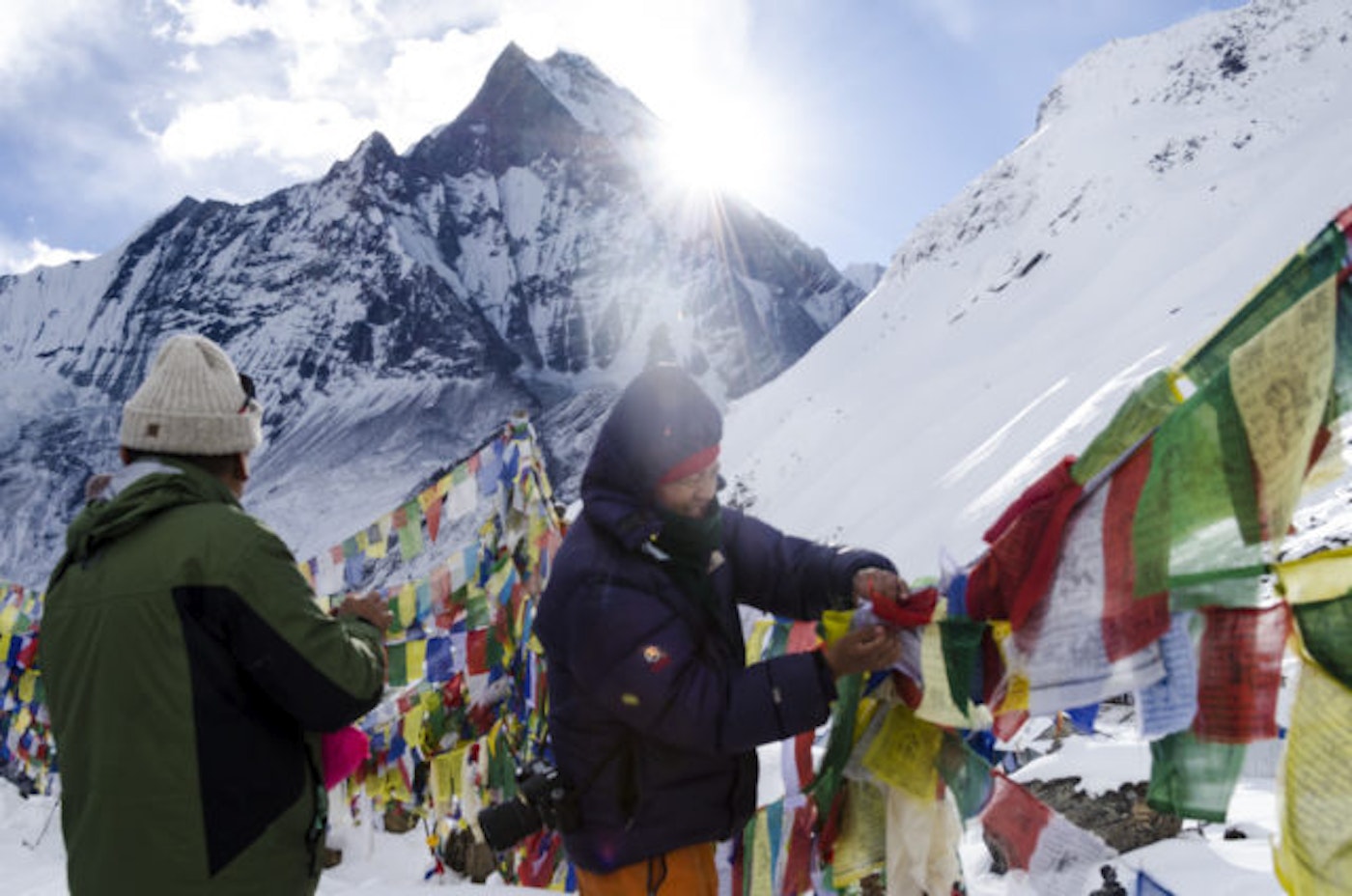
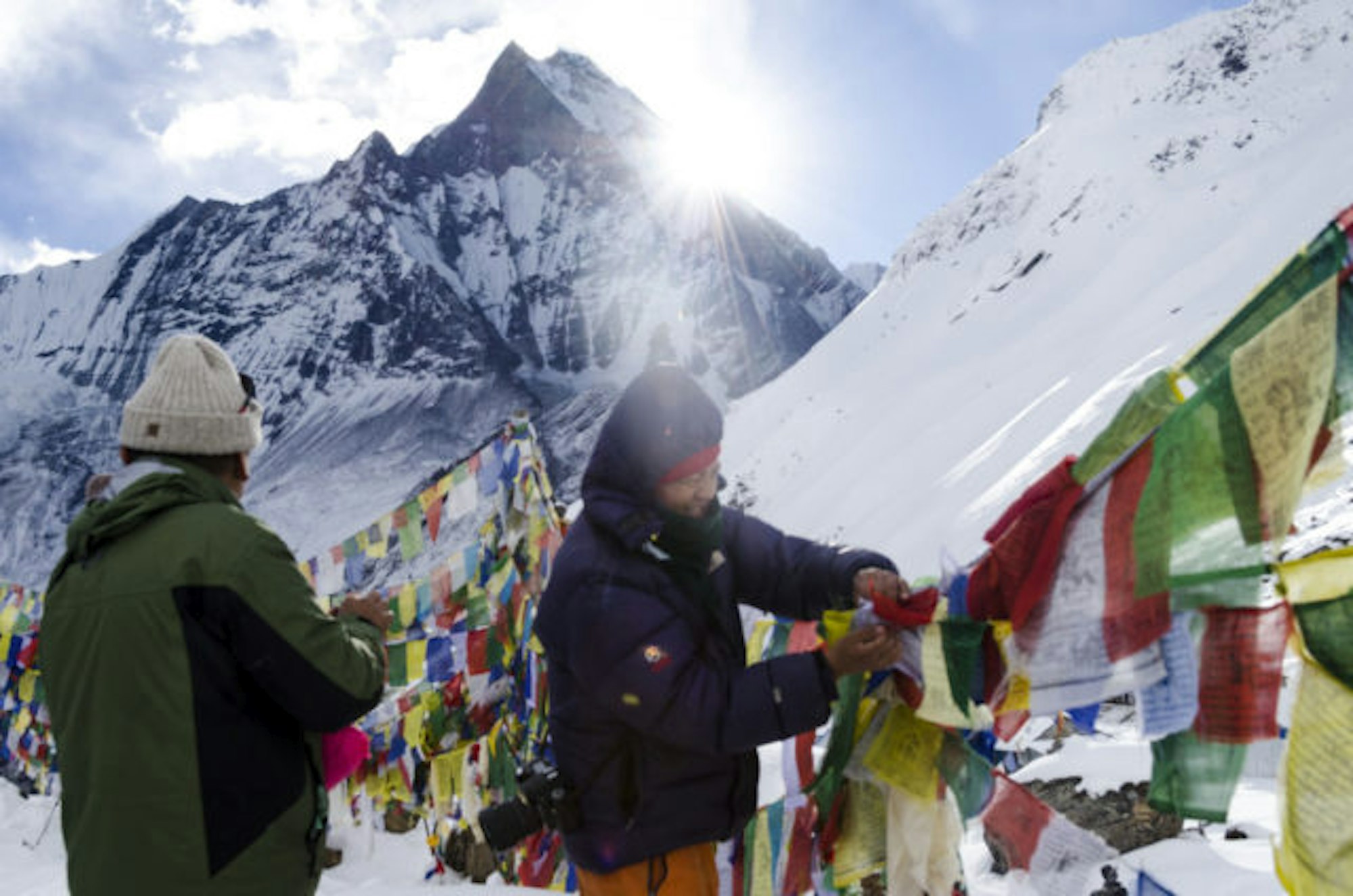
Hanging prayer flags is a longtime Himalayan tradition; now, skiing finds its place in the community.
Nepali history can, at times, be difficult to interpret, as consistency is not a strength of the culture. For example, many teahouse owners said we were the first people they had seen with skis while others claimed to have seen many before. It is known that Warren Miller Entertainment had come to Annapurna Base Camp to document skiing in the area years ago. Adventure skier Chris Davenport has also been to the area, conquering the Lhotse Face on skis in 2011. Currently, many foreign athletes are developing the sport of ski mountaineering in the area by marking first descents. Additionally, heli-skiing is still a popular option in Nepal during specific months of the year. However, the operation costs a considerable amount of money which locals cannot afford.
Once at base camp, Jason and I were relieved to find plenty of fresh snow and beautiful lines. However, the snow consistency was wet and deep without a solid base formed. To complete our experience, the equipment provided by NFSS was roughly 10 years old. The skis had suffered obvious damage while the skins appeared mistreated to the point of no longer sticking to bases. Therefore, boot packing would be our only approach method. Post-holing for hours, Jason and I sunk our boots into waist-high powder and found steep walls of formidable snow denying access to the holy mountainside. With base camp resting at 13,500 feet, ascending further in such difficult conditions required many breaks.
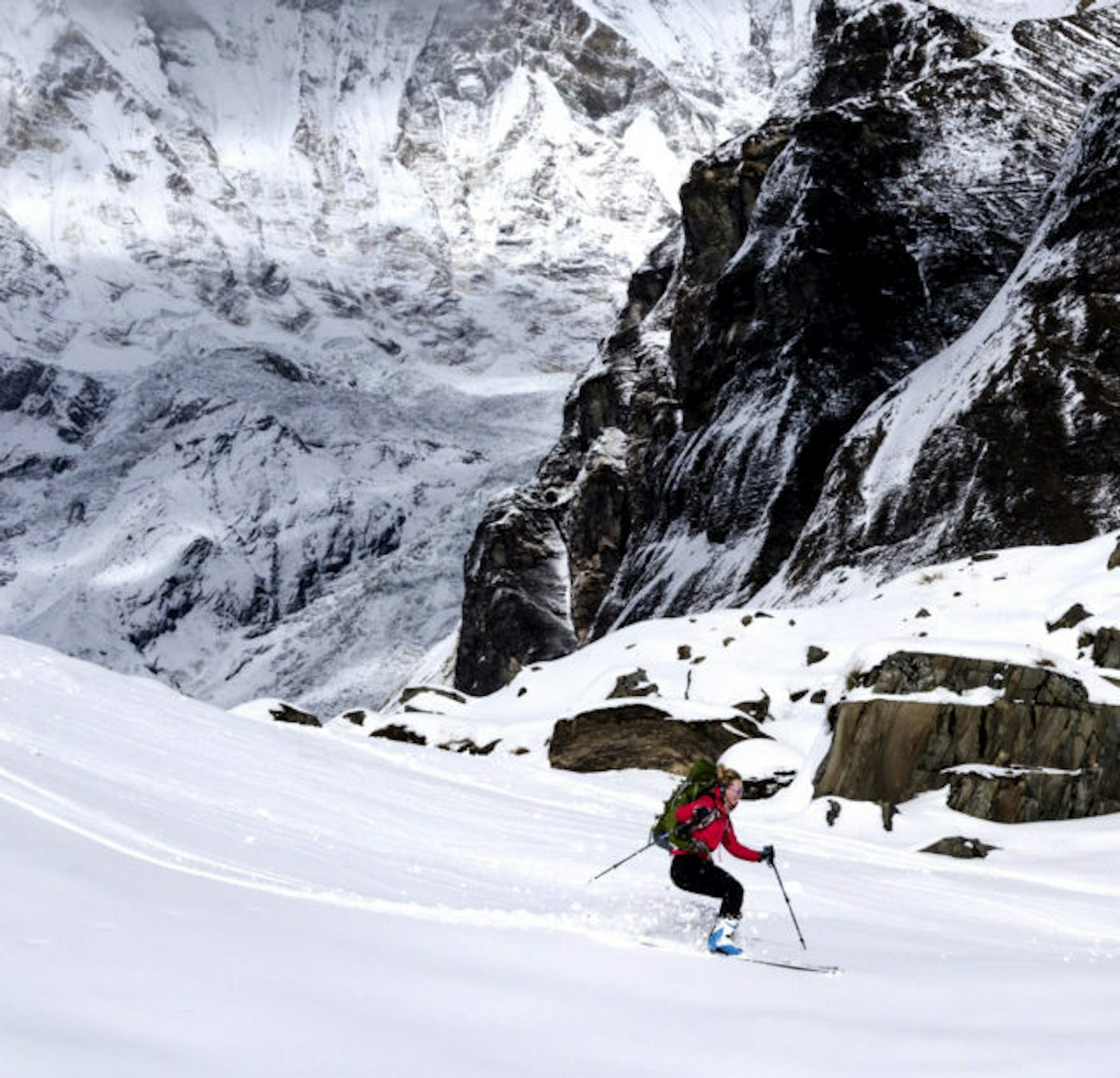
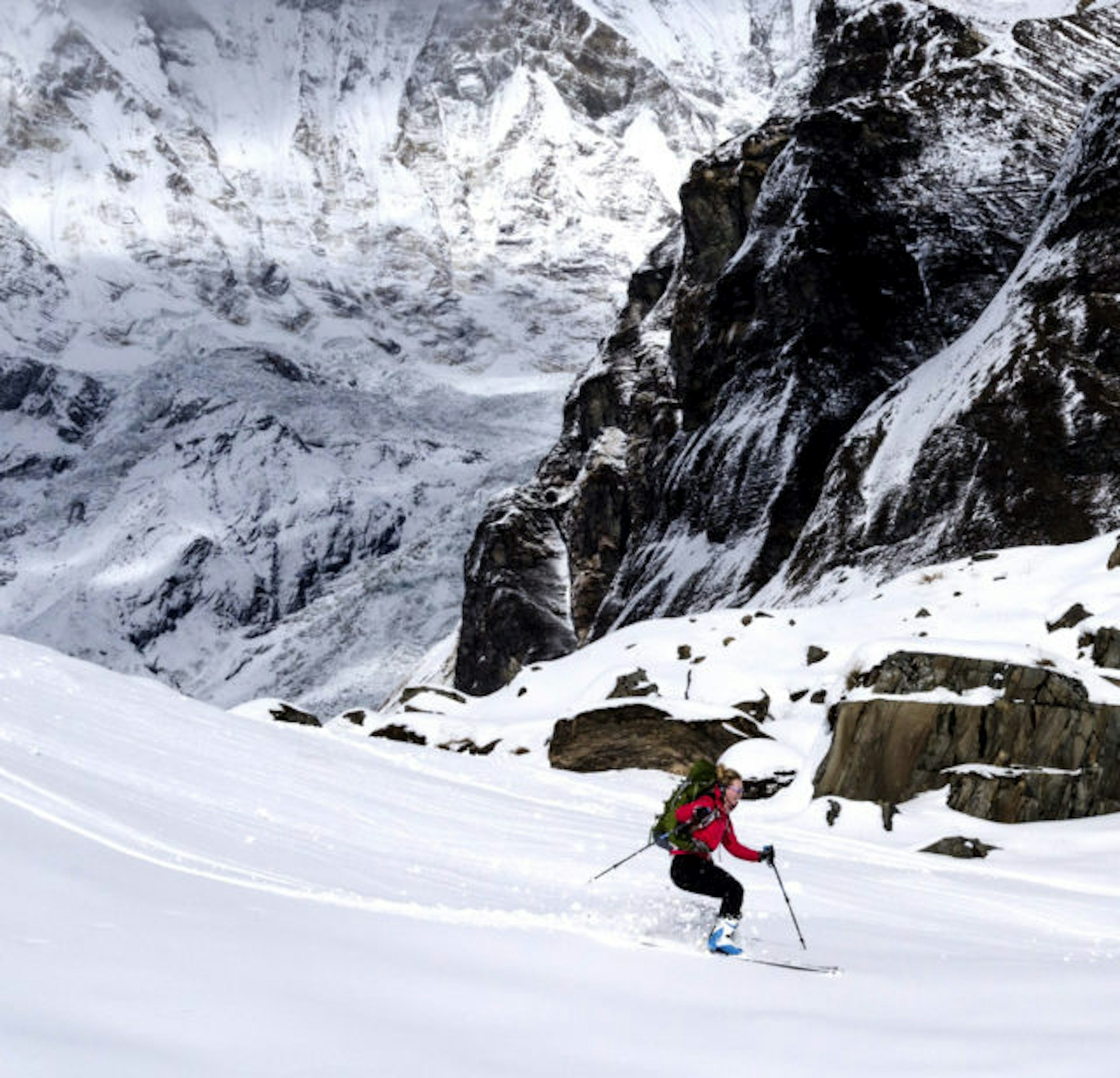
While trying to fill our lungs with air, it was impossible not to take a moment and revel in the surrounding beauty. The mountains of the Annapurna range rise from eroding cliffs like shards of splintered glass slicing the sky and refracting light. These daunting divides split clouds, dissipating upon summits as if the peak exhaled a slow sigh into frigid winter air. None held the image more truly than Machapuchare. Towering high above the surrounding peaks at 22,943 feet, the granite deity is believed to be home to the Hindu god, Shiva. Undeniably, the mountains have a powerful and present personality.
On our second day at ABC, we decided to test out a gradual slope nestled next to a teahouse lodge. The owner of the Annapurna Lodge noticed us skiing and decided to join in. He brought out two snowboards he had acquired and the local workers hopped on to play on the easy hill with us. Sliding, carving, flopping and laughing, the Nepali workers were some of the most playful and genuinely happy people I’ve ever seen on a slope.
The experience of skiing amongst Nepal’s goliath Himalayas truly embodies the backcountry term “earn your turns.” Strenuous approaches often produce only a single-run. Working for multiple consecutive days, enduring hours of trekking with an onerous load, consistently questioning if the end goal is even possible makes for a mental and physical struggle. Yet the suffering enhances the reward. To finally reach snow line, to be surrounded by the tallest peaks in the world, to sense the spiritual energy in an utterly remote area and then to carve down the mountain while embracing that the goal is possible—it makes for the perfect moment. Through the continued support and education of local guides by the Ski and Snowboard Nepal Foundation, the Nepali Himalayas have the prospect to develop into some of the most pristine remote skiing that many backcountry enthusiasts are seeking.

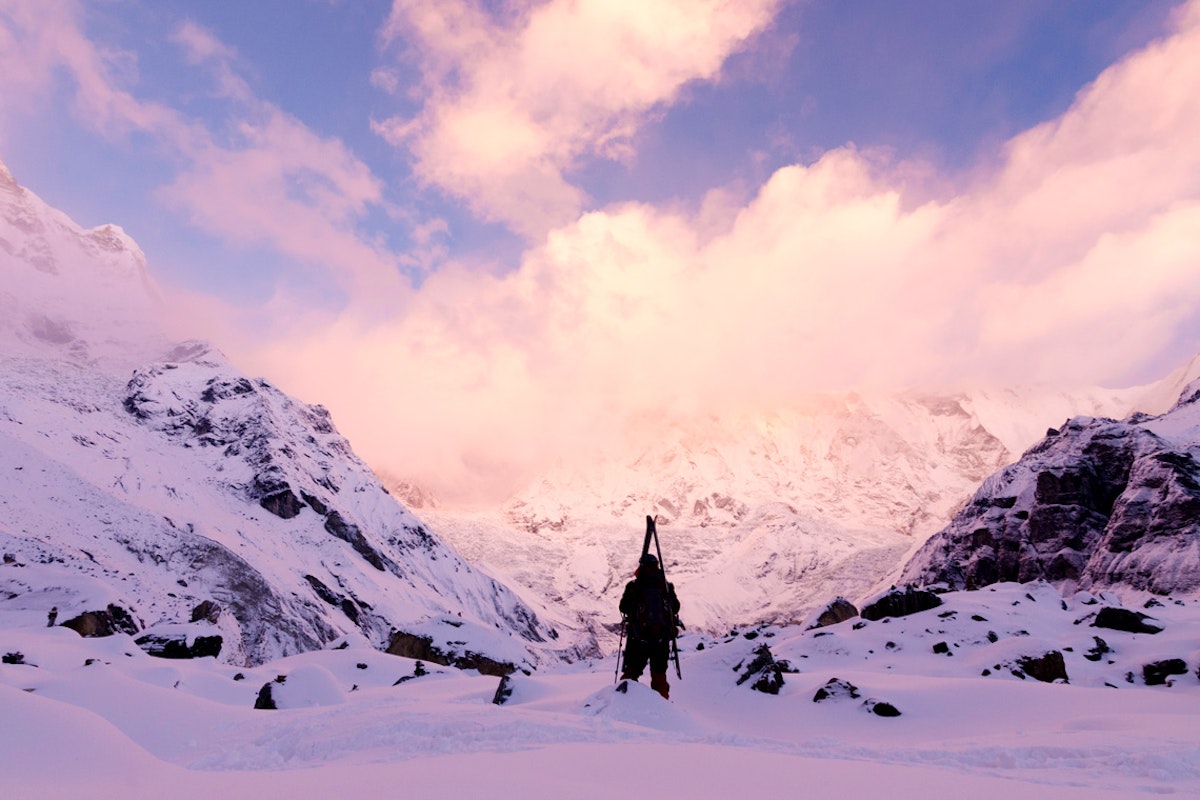
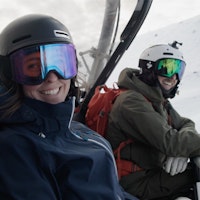
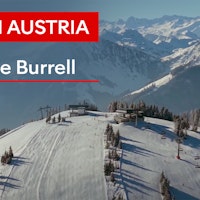
![[GIVEAWAY] Win a Head-to-Toe Ski Setup from IFSA](https://www.datocms-assets.com/163516/1765920344-ifsa.jpg?w=200&h=200&fit=crop)
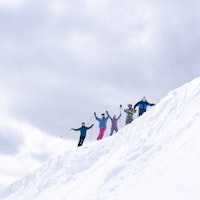
![[GIVEAWAY] Win a Legendary Ski Trip with Icelantic's Road to the Rocks](https://www.datocms-assets.com/163516/1765233064-r2r26_freeskier_leaderboard1.jpg?auto=format&w=400&h=300&fit=crop&crop=faces,entropy)
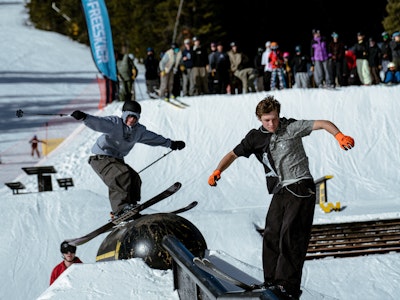
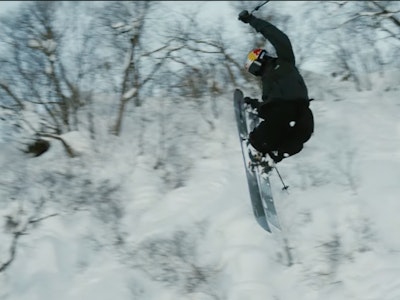

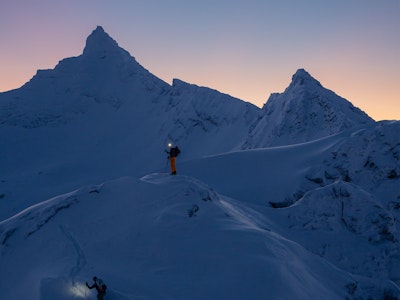
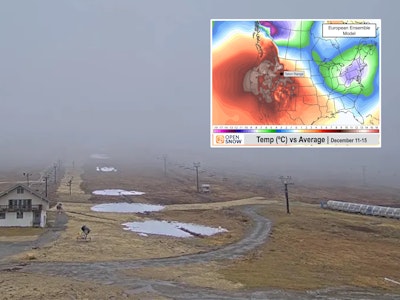
![[GIVEAWAY] Win a Head-to-Toe Ski Setup from IFSA](https://www.datocms-assets.com/163516/1765920344-ifsa.jpg?auto=format&w=400&h=300&fit=crop&crop=faces,entropy)
